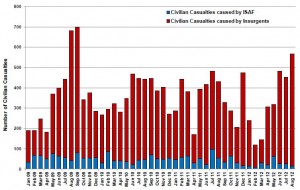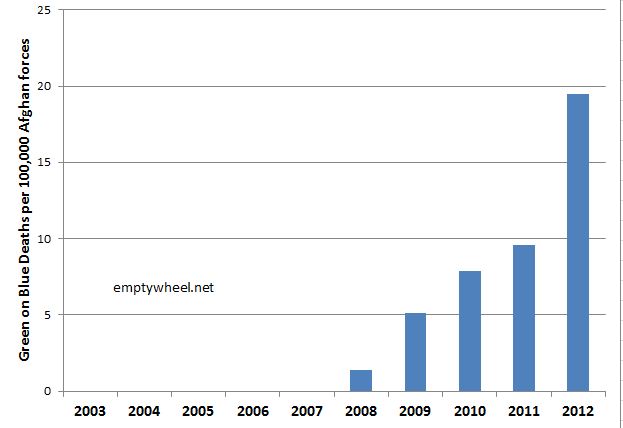How NATO Will Game the Numbers on Afghan National Security Force Size
Last month, when the combination of rising green on blue killings and anger over the anti-Islam film finally shut down most joint operations between NATO and Afghan forces, I predicted that this would lead quickly to Afghan National Security Forces falling below the level of 350,000 that NATO has stated to be the goal when security responsibility for the country shifts to Afghan control as NATO withdraws. The prediction was based on already knowing that Afghan forces suffer from huge attrition losses and knowing that the most important aspect of training for Afghan troops occurs during joint patrols that are carried out at the platoon level where only a handful of troops from each side are present. The shutdown of joint operations was for everything below the battalion level, so it seemed to me that with the most important level of training ended, ongoing attrition would decimate the force size.
While reading today’s New York Times article in which the Times has finally realized what a huge problem the high attrition rate poses, I finally deciphered how NATO will be gaming the numbers on ANSF size in order to claim that the original plan for withdrawal can be followed without significant changes. The Times tells us:
Now at its biggest size yet, 195,000 soldiers, the Afghan Army is so plagued with desertions and low re-enlistment rates that it has to replace a third of its entire force every year, officials say.
The attrition strikes at the core of America’s exit strategy in Afghanistan: to build an Afghan National Army that can take over the war and allow the United States and NATO forces to withdraw by the end of 2014. The urgency of that deadline has only grown as the pace of the troop pullout has become an issue in the American presidential campaign.
The reality is that although NATO has set a goal for ANSF size to allow withdrawal, it has completely given up on the idea of those Afghan forces being fully functional. My error when I predicted that cessation (now followed by a resumption that Panetta claims is “nearly normal”) of joint patrols would reduce force size was to think that ANSF size would be at all affected by a decreased level of training and experience gained on joint patrol.
NATO will continue to claim that ANSF size is at the goal for withdrawal because, as we see in the Times article, recruitment will continue at the rate needed to make up for the high attrition rate. Recruitment is all that matters for maintaining force size, as the Times noted:
Colonel Stanikzai, a senior official at the army’s National Recruiting Center, is on the front line of that effort; in the six months through September, he and his team of 17 interviewers have rejected 962 applicants, he said.
“There are drug traffickers who want to use our units for their business, enemy infiltrators who want to raise problems, jailbirds who can’t find any other job,” he said. During the same period, however, 30,000 applicants were approved.
“Recruitment, it’s like a machine,” he said. “If you stopped, it would collapse.” Read more →



